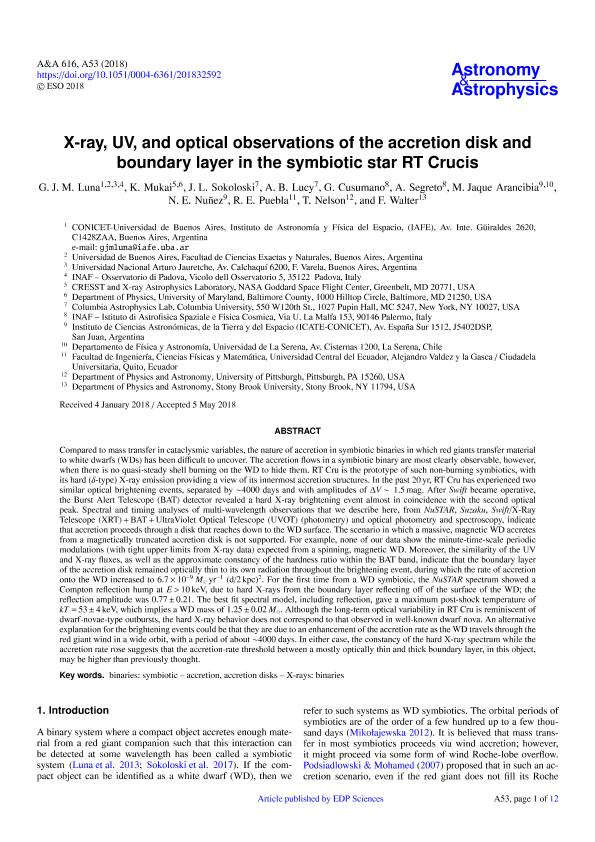Mostrar el registro sencillo del ítem
dc.contributor.author
Luna, Gerardo Juan Manuel

dc.contributor.author
Mukai, K.
dc.contributor.author
Sokoloski, J. L.
dc.contributor.author
Lucy, A. B.
dc.contributor.author
Cusumano, G.
dc.contributor.author
Segreto, A.
dc.contributor.author
Jaque Arancibia, Marcelo Daniel

dc.contributor.author
Nuñez, Natalia Edith

dc.contributor.author
Puebla, R. E.
dc.contributor.author
Nelson, T.
dc.contributor.author
Walter, F. M.
dc.date.available
2019-10-18T15:10:56Z
dc.date.issued
2018-05
dc.identifier.citation
Luna, Gerardo Juan Manuel; Mukai, K.; Sokoloski, J. L.; Lucy, A. B.; Cusumano, G.; et al.; X-ray, UV, and optical observations of the accretion disk and boundary layer in the symbiotic star RT Crucis; EDP Sciences; Astronomy and Astrophysics; 616; 5-2018; 53-65
dc.identifier.issn
0004-6361
dc.identifier.uri
http://hdl.handle.net/11336/86338
dc.description.abstract
Compared to mass transfer in cataclysmic variables, the nature of accretion in symbiotic binaries in which red giants transfer material to white dwarfs (WDs) has been difficult to uncover. The accretion flows in a symbiotic binary are most clearly observable, however, when there is no quasi-steady shell burning on the WD to hide them. RT Cru is the prototype of such non-burning symbiotics, with its hard (δ-type) X-ray emission providing a view of its innermost accretion structures. In the past 20 yr, RT Cru has experienced two similar optical brightening events, separated by ∼ 4000 days and with amplitudes of ΔV ∼ 1.5 mag. After Swift became operative, the Burst Alert Telescope (BAT) detector revealed a hard X-ray brightening event almost in coincidence with the second optical peak. Spectral and timing analyses of multi-wavelength observations that we describe here, from NuSTAR, Suzaku, Swift/X-Ray Telescope (XRT) + BAT + UltraViolet Optical Telescope (UVOT) (photometry) and optical photometry and spectroscopy, indicate that accretion proceeds through a disk that reaches down to the WD surface. The scenario in which a massive, magnetic WD accretes from a magnetically truncated accretion disk is not supported. For example, none of our data show the minute-time-scale periodic modulations (with tight upper limits from X-ray data) expected from a spinning, magnetic WD. Moreover, the similarity of the UV and X-ray fluxes, as well as the approximate constancy of the hardness ratio within the BAT band, indicate that the boundary layer of the accretion disk remained optically thin to its own radiation throughout the brightening event, during which the rate of accretion onto the WD increased to 6.7 × 10-9M· yr-1 (d/2 kpc)2. For the first time from a WD symbiotic, the NuSTAR spectrum showed a Compton reflection hump at E > 10 keV, due to hard X-rays from the boundary layer reflecting off of the surface of the WD; the reflection amplitude was 0.77 ± 0.21. The best fit spectral model, including reflection, gave a maximum post-shock temperature of kT = 53 ± 4 keV, which implies a WD mass of 1.25 ± 0.02 M·. Although the long-term optical variability in RT Cru is reminiscent of dwarf-novae-type outbursts, the hard X-ray behavior does not correspond to that observed in well-known dwarf nova. An alternative explanation for the brightening events could be that they are due to an enhancement of the accretion rate as the WD travels through the red giant wind in a wide orbit, with a period of about ∼4000 days. In either case, the constancy of the hard X-ray spectrum while the accretion rate rose suggests that the accretion-rate threshold between a mostly optically thin and thick boundary layer, in this object, may be higher than previously thought.
dc.format
application/pdf
dc.language.iso
eng
dc.publisher
EDP Sciences

dc.rights
info:eu-repo/semantics/openAccess
dc.rights.uri
https://creativecommons.org/licenses/by-nc-sa/2.5/ar/
dc.subject
ACCRETION, ACCRETION DISKS
dc.subject
BINARIES: SYMBIOTIC
dc.subject
X-RAYS: BINARIES
dc.subject.classification
Astronomía

dc.subject.classification
Ciencias Físicas

dc.subject.classification
CIENCIAS NATURALES Y EXACTAS

dc.title
X-ray, UV, and optical observations of the accretion disk and boundary layer in the symbiotic star RT Crucis
dc.type
info:eu-repo/semantics/article
dc.type
info:ar-repo/semantics/artículo
dc.type
info:eu-repo/semantics/publishedVersion
dc.date.updated
2019-10-17T19:10:40Z
dc.journal.volume
616
dc.journal.pagination
53-65
dc.journal.pais
Francia

dc.journal.ciudad
Paris
dc.description.fil
Fil: Luna, Gerardo Juan Manuel. Consejo Nacional de Investigaciónes Científicas y Técnicas. Oficina de Coordinación Administrativa Ciudad Universitaria. Instituto de Astronomía y Física del Espacio. - Universidad de Buenos Aires. Facultad de Ciencias Exactas y Naturales. Instituto de Astronomía y Física del Espacio; Argentina
dc.description.fil
Fil: Mukai, K.. National Aeronautics and Space Administration; Estados Unidos
dc.description.fil
Fil: Sokoloski, J. L.. Columbia University; Estados Unidos
dc.description.fil
Fil: Lucy, A. B.. Columbia University; Estados Unidos
dc.description.fil
Fil: Cusumano, G.. Istituto Nazionale di Astrofisica; Italia
dc.description.fil
Fil: Segreto, A.. Istituto Nazionale di Astrofisica; Italia
dc.description.fil
Fil: Jaque Arancibia, Marcelo Daniel. Consejo Nacional de Investigaciones Científicas y Técnicas. Centro Científico Tecnológico Conicet - San Juan. Instituto de Ciencias Astronómicas, de la Tierra y del Espacio. Universidad Nacional de San Juan. Instituto de Ciencias Astronómicas, de la Tierra y del Espacio; Argentina
dc.description.fil
Fil: Nuñez, Natalia Edith. Consejo Nacional de Investigaciones Científicas y Técnicas. Centro Científico Tecnológico Conicet - San Juan. Instituto de Ciencias Astronómicas, de la Tierra y del Espacio. Universidad Nacional de San Juan. Instituto de Ciencias Astronómicas, de la Tierra y del Espacio; Argentina
dc.description.fil
Fil: Puebla, R. E.. Universidad Central del Ecuador; Ecuador
dc.description.fil
Fil: Nelson, T.. University of Pittsburgh at Johnstown; Estados Unidos
dc.description.fil
Fil: Walter, F. M.. Columbia University; Estados Unidos
dc.journal.title
Astronomy and Astrophysics

dc.relation.alternativeid
info:eu-repo/semantics/altIdentifier/doi/http://dx.doi.org/10.1051/0004-6361/201832592
Archivos asociados
